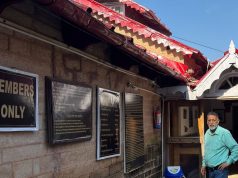 By Col Bhaskar Bharti (Retd)
By Col Bhaskar Bharti (Retd)
Theatre is a mirror, a sharp reflection of society- Yasmina Reza
Uttarakhand has transformed itself into ‘India’s Most Film Friendly State’. It has carved its space in cinema with breathtaking locations and progressive policies with ease of doing business. But cinema is not the only art form that defines the cultural identity of our hill state. Long before film crews arrived here, the region nurtured storytellers through its folk performances, ritual dramas, and theatre. Just as the state has emerged as a cinematic hub, it holds equal potential to become the Theatre Capital of India. With proper investments, institutional support, and cultural vision, Uttarakhand can surely give theatre the stage it deserves.
The Partition of India in 1947 brought massive demographic, cultural, and emotional upheavals across the subcontinent. In the small but vibrant town of Dehradun, nestled in the foothills of the Himalayas, the impact of Partition was deeply felt—not just socially and politically, but artistically as well. Amid the resettlement of refugees and the redefinition of identity, theatre in Dehradun evolved as both a mirror and balm for a society in flux.
Growing Stages, Changing Themes
In the decades that followed, Dehradun and other towns saw the emergence of several theatre groups that defined the cultural pulse of the state. These groups represent a bridge between folk and modern, rural and urban, traditional and experimental. The themes of Uttarakhand’s theatre have always been reflective of its society. In the post-Partition years, refugee struggles and identity crises dominated. Later decades brought stories of environmental degradation, unemployment, migration, and gender inequality. Plays began addressing the fragile ecology of the Himalayas, echoing Chipko-inspired movement. Street theatre (nukkad natak) became a medium to raise awareness in marketplaces and schools. The language of the stage shifted between Hindi, English Garhwali, Kumaoni, Punjabi, and Urdu — preserving diversity while ensuring relevance. Traditional folk-ritual forms like the Machh Maun of Jaunsar Bawar, Ramlila of Almora and Ramman of Garhwal (recognised by UNESCO) continue to influence modern productions with their music, costumes, and community ethos. Uttarakhand boasts of very renowned theatre personalities and theatre groups, who have contributed in preserving the art and craft of theatre since independence: Lalit Mohan Thapliyal (Sadhna Kala Kendra), Urmil Thapliyal (Darpan) , Mohan Upreti and Naima Khan (Parvatiya Kala Kendra), Tom Alter, Himani Shivpuri, Uzra Butt, BM Shah, Tribhuwan Giri Maharaj (Hukka Club), Avi Nanda (Shristi), Zahur Alam (Yug Manch), Gajendra Verma (Vatayan), TK Aggarwal and Jagriti Dobhal (Kala Manch), Alok Ulfat (Avikal), Shirish Dobhal (Shailnat), Dr Suwarn Rawat (Kala Darpan), Hari Semwal (The High Hillers), Prof DR Purohit (Vidyadhar’s SRICALA), SP Mamgain (Meghdoot), Chandermohan Baunthiyal, Lalit Pokhriya (NISARG), Vijay Vashishth (Akshat), Abhishek Maindola (Sambhav Manch), Nivedita Baunthiyal (Rangaayan Association), Shishir Sharma, Surendra Bhandari, Mukesh Dhasmana, Rahul Sharma, Anil Gupta, Ramesh Dobriyal (Yugantar), Akhilesh Narayan (Eklavya), Vishal Savan (Prayas Jagrukta Manch), Rakesh Bhatt (Utsav), Kailash Kandwal (Dhaad), Hem Pant (Lok Kala Manch), Bhupesh Joshi (Gaatha), Laxmi Rawat (Pragya), Kailash Kumar (Bhaav Raag), Madan Singh Mehra (Prayogank), Rinku Singh and Harshit Verma (Abhinaya Cultural Society), Yuv Manch, Jagriti, Shilpi, ONGC Theatre Group and many more.
Curtain Raisers and Roadblocks
Despite its rich heritage, theatre in Uttarakhand faces formidable challenges:
- Infrastructure: Very few dedicated auditoriums exist, and most groups perform in schools or makeshift venues.
- Finances: Productions are largely voluntary, and ticket revenues are minimal.
- Audience: Competing with cinema, digital platforms and televisions, theatre struggles to attract younger generations.
- Institutional Support: Unlike Delhi or Mumbai, Dehradun and other towns lack consistent state or corporate patronage.
- Talent Drain: The best actors often migrate to bigger cities for opportunities, weakening the local theatre.
These challenges, if not addressed, risk reducing theatre to nostalgia rather than a living art form.
The Way Forward
And yet, the story is far from bleak. Theatre groups are increasingly using social media and YouTube to amplify their reach. Youth workshops, collaborations with universities, and community festivals have ensured a steady trickle of new talent. But real transformation requires systemic interventions:
- Institutional Anchors: Establishing campuses akin to National School of Drama (NSD), Bhartendu Natya Academy (BNA), or Madhya Pradesh School of Drama (MPSD) in Uttarakhand would create professional training ecosystems.
- National Theatre Festival: Hosting an annual festival in Uttarakhand could give the state the same stature in theatre that Goa enjoys in cinema through IFFI.
- Infrastructure Development: Dedicated black-box theatres and cultural complexes in cities like Dehradun, Haridwar, Nainital, Rudrapur, Almora, Pauri and Tehri would nurture consistent productions.
- Subsidise Rentals for Auditoriums: Subsidies should be given to existing registered theatre groups in Himalayan Cultural Centre, IRDT Auditorium, New Townhall, Cultural Department Sabhagar and other state managed auditoriums. Reputed Organisations like ONGC, IIP, FRI, WLI, Cantt Board and other educational institutions and Universities should provide the facilities of their existing auditoriums with subsidised rentals for maintenance and upkeep.
- Financial Support: State-backed fellowships, corporate sponsorships, and CSR funding could provide stability to groups struggling for resources.
- Youth Engagement: Theatre in schools and colleges, coupled with street theatre initiatives, could rebuild an audience culture. Initiatives and courses by Theatre Department of Doon University need to be commended and it can act as a role model for other Institutions and Colleges.
- Hybrid Formats: Blending live performance with digital streaming would expand audiences while retaining intimacy.
Curtain Call
Theatre in Uttarakhand is not a relic of the past but a living, breathing art form that has adapted to every historical turn since Partition. From refugee halls of the 1940s to the experimental studios of today, the journey of the stage here is one of resilience and reinvention. As Uttarakhand enjoys its place as India’s most film-friendly state, it is time to extend that vision to the stage. With focused policies, institutional backing, and creative festivals, the state can become India’s Most Theatre-Friendly State. The Himalayas, then, will not just stand as scenic backdrops for cinema, but as timeless stages where India’s finest dramas continue to unfold.
(Col Bhaskar Bharti is an Indian Army veteran. He is an alumnus of the NDA & IMA. He had an illustrious military career of 33 years. He is a PG in Journalism & Mass Communication & PG in Human Resource Management. He is a theatre enthusiast based in Dehradun.)






